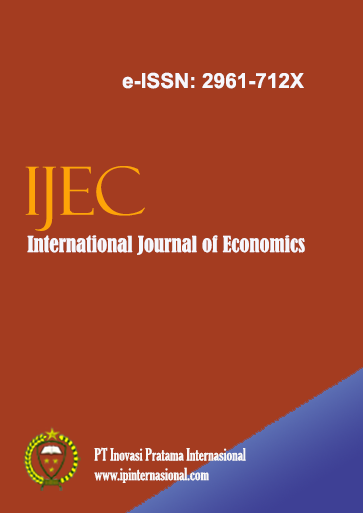The Influence of Human Capital, Infrastructure Availability and Minimum Wages on Labor Absorption in Eastern Indonesia
Main Article Content
Abstract
This study aims to determine and analyze the influence of health factors, education, infrastructure availability and minimum wages on labor absorption both directly and through private investment and economic growth. This study uses secondary data in the form of life expectancy data, average length of schooling, distributed energy, provincial minimum wages, private investment (PMA and PMDN), GRDP, economic growth, and the number of working population in each province in Eastern Indonesia. The data is in the form of N The results of the study show that directly health factors, education, and provincial minimum wages have a negative and significant effect on labor absorption while infrastructure availability has a positive and significant effect. Indirectly health factors, infrastructure availability and minimum wages are able to increase labor absorption both through investment and economic growth in contrast to the education factor which has not maximized labor absorption both through investment and economic growth. This is in line with the conditions of KTI which are still dominated by informal sector employment.
Downloads
Article Details

This work is licensed under a Creative Commons Attribution 4.0 International License.
References
A Jordaan, J. (2008). State Characteristics and the Locational from Regional FDI in Mexico 1989 – 2006. Growth and Change, 39(3), 389–413.
B. S Frank R. H., & B. (2007). Principles of Microeconomics (3rd ed.). McGraw- Hill/Irwin.
Bakar, N. A. A., & Mat, S. H. C. (2017). The Effects of Infrastructure Development on Economic Growth in the Northern States of Malaysia. Quest Journals - Journal of Research in Humanities and Social Science, 5(9), 28–32. http://www.questjournals.org/jrhss/papers/vol5-issue9/F592832.pdf
Bakar, N. A., Mat, S. H. C., & Harun, M. (2012). The Impact of Infrastructure on Foreign Direct Investment: The Case of Malaysia. Procedia - Social and Behavioral Sciences, 65, 205–211. https://doi.org/10.1016/j.sbspro.2012.11.112
Balisacan, A. M., & Fuwa, N. (2004). Going beyond crosscountry averages: Growth, inequality and poverty reduction in the Philippines. World Development,
Budiasih, J. D. B., & Asmara, A. (2024). Pengaruh Pendidikan, UMK, Dan PDRB Terhadap Penyerapan Tenaga Kerja Di Provinsi Banten Tahun 2012 –2021. JEMSI (Jurnal Ekonomi, Manajemen, Dan Akuntansi), 10(2), 826–836.
Budiwan, I., Fauzi, A., & Falatehan, A. F. (2020). Analisis Pengaruh Konsumsi Energi Terhadap Pertumbuhan Ekonomi dan Emisi Karbon Dioksida di Indonesia. Environmental Economics.
Byrne, B. M. (1998). Structural equation modeling with LISREL, PRELIS, and SIMPLIS : basic concepts, applications, and programming. In Multivariate applications book series.
Calderón, C., Moral-Benito, E., & Servén, L. (2015). Is infrastructure capital productive? A dynamic heterogeneous approach. Journal of Applied Econometrics, 30(2). https://doi.org/10.1002/jae.2373
Czernich, N., Falck, O., Kretschmer, T., & Woessmann, L. (2011). Broadband Infrastructure and Economic Growth. Economic Journal, 121(552). https://doi.org/10.1111/j.1468-0297.2011.02420.x
dan D.Green Becker, S. (1962). Budgeting and Employee Behavior. Journal Of Business, 392–402.
dan Nordhaus, S. (2001). Microeconomics (17th ed.). Mc Graw-hill Companies. Delivarnov. (1995). Pengantar Ekonomi Makro. UI Press.
Démurger, S. (2001). Infrastructure Development and Economic Growth: An Explanation for Regional Disparities in China? Journal of Comparative Economics, 29(1), 95–117. https://doi.org/10.1006/jcec.2000.1693
Deng, T. (2013). Impacts of Transport Infrastructure on Productivity and Economic Growth: Recent Advances and Research Challenges. In Transport Reviews (Vol. 33, Issue 6). https://doi.org/10.1080/01441647.2013.851745
Dewi, D. C., Mardiyono, M., & Soeaidy, S. (2015). Implementation Of The Local Minimum Wage In Malang City (A Case Study in Malang City 2014). Wacana, Jurnal Sosial Dan
Hull, K. (2009). Understanding the Relationship between Economic Growth , Employment and Poverty Reduction *. Promoting Pro-Poor Growth: Employment.
Hulland, J., Chow, Y. H., & Lam, S. (1996). Use of causal models in marketing research: A review. International Journal of Research in Marketing. https://doi.org/10.1016/0167-8116(96)00002-X
Luttmer, E. F. P. (2007). Does the minimum wage cause inefficient rationing? B.E. Journal of Economic Analysis and Policy. https://doi.org/10.2202/1935- 1682.1768
Luu, H. N., Nguyen, N. M., Ho, H. H., & Tien, D. N. (2019). Infrastructure and economic development in developing economies: New empirical evidence from night- time satellite imagery in Vietnam. International Journal of Social Economics, 46(4), 581–594. https://doi.org/10.1108/IJSE-05-2018-0252
Madugba, J. U., Oparah, V. I., & Onuoha, C. J. (2022). Effect of Human Capital Investment on Economic Growth: Nigeria Perspective. Turk Turizm Arastirmalari Dergisi. https://doi.org/10.26677/tr1010.2022.10
Malcomson, J. M. (1981). Unemployment and the Efficiency Wage Hypothesis. The Economic Journal, 91(364). https://doi.org/10.2307/2232496
Mankiw, N. G. (2003a). Macroeconomics. Worth Publisher. Mankiw, N. G. (2003b). Macroeconomics. Worth Publisher.
Mankiw, N. G. (2017). N. Gregory Mankiw, Macroeconomics, 7th Edition.pdf. In
Macroeconomics, 7th Edition.
Maqin, A. (2011). Pengaruh Kondisi Infrastruktur Terhadap Pertumbuhan Ekonomi di Jawa Barat. Trikonomika, 10(1).
Marie-Estelle, B., & Facchini, F. (2013). Okun’s law in the french regions: A cross- regional comparison. Economics Bulletin, 33(1), 420–433.
Martinkus, B., & Lukaševičius, K. (2008). Investment environment of Lithuanian resorts: Researching national and local factors in the Palanga case. Transformations in Business and Economics, 7(2).
Maryaningsih, N., Hermansyah, O., & Savitri, M. (2014). The Role of Infrastructure on Economic Growth in Indonesia. Bulletin of Monetary, Economics and Banking, 17, 55–88.
Masoud Mohamed Suleiman, N. N. & A. (2014). Dynamic relationship between tourism, trade, infrastructure and economic growth: Empirical evidence From Malaysia. Journal of African Studies and Development, 6(3), 49–55. https://doi.org/10.5897/jasd2013.0260
McDonald, R. P., & Marsh, H. W. (1990). Choosing a multivariate model: Noncentrality and goodness of fit. Psychological Bulletin. https://doi.org/10.1037/0033- 2909.107.2.247
Meer, J., & West, J. (2016). Effects of the minimum wage on employment dynamics. Journal of Human Resources, 51(2), 500–522. https://doi.org/10.3368/jhr.51.2.0414-6298R1
Yuda Pratama, M., Rahmi, D., & Amaliah, I. (2022). Pengaruh Investasi, Upah Minimum Provinsi (UMP), dan Indeks Pembangunan Manusia (IPM) terhadap Penyerapan Tenaga Kerja di Pulau Jawa Tahun 2010-2020. Bandung Conference Series: Economics Studies, 2(1). https://doi.org/10.29313/bcses.v2i1.1406
Zavodny, M. (2000). The effect of the minimum wage on employment and hours. Labour Economics, 7(6), 729–750. https://doi.org/10.1016/S0927- 5371(00)00021-X
Zhang, K. H., & Markusen, J. R. (1999). Vertical multinationals and host-country characteristics. Journal of Development Economics, 59(2). https://doi.org/10.1016/S0304-3878(99)00011-5
Zipperer, B. (2016). Did the minimum wage or the Great Recession reduce low-wage employment? Comments on Clemens and Wither (2016). Washington Center for Equitable Growth Working Paper.

